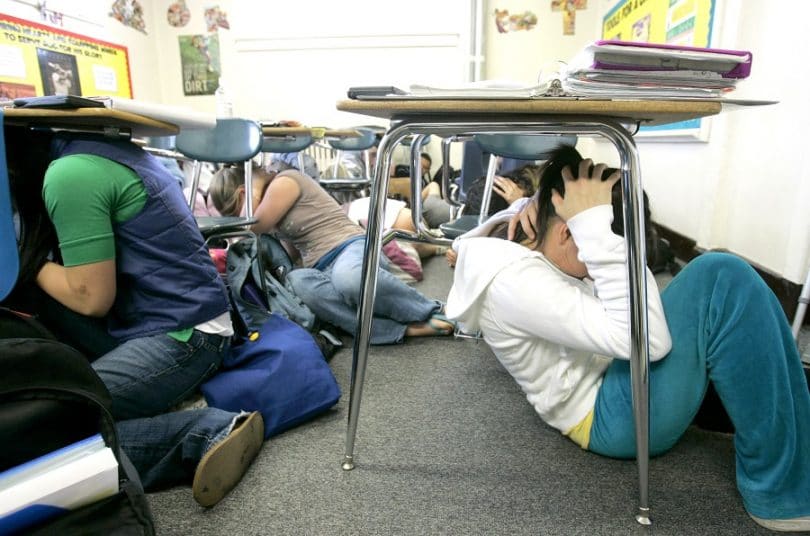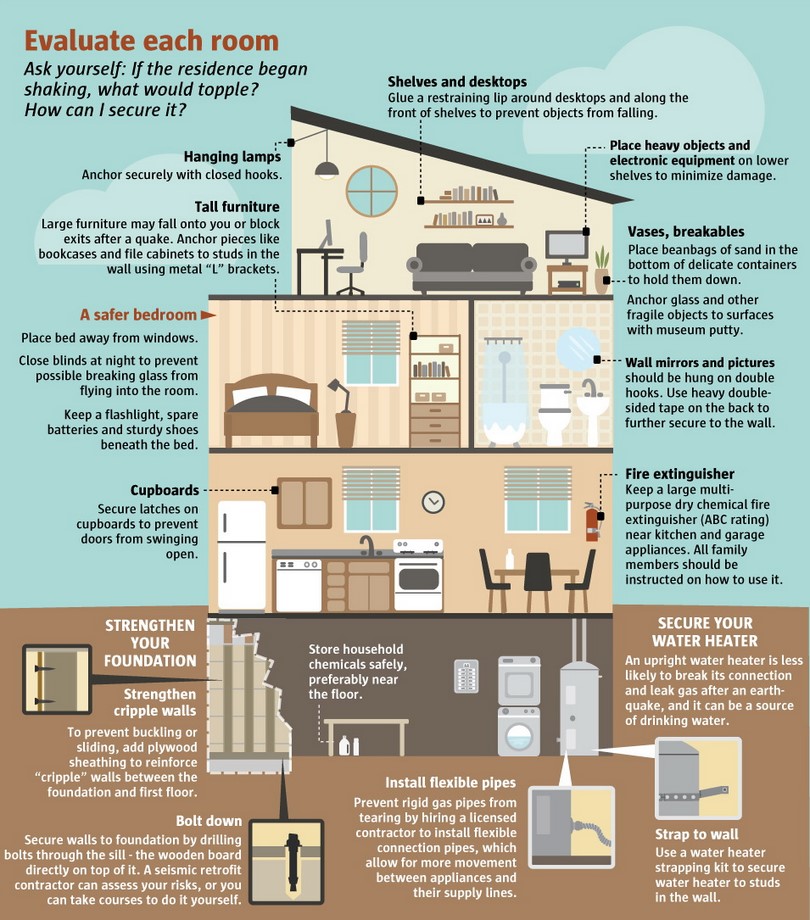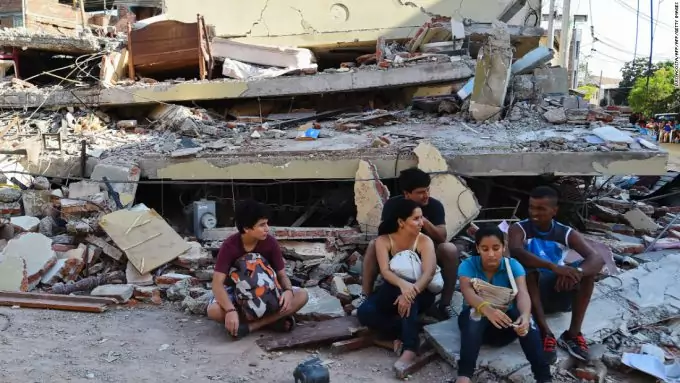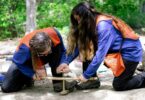Earthquakes are interesting and impressive natural phenomena, with a tremendous power of destruction and the ability to frighten even the most prepared man on the planet. On today’s “how to prepare for an earthquake” lesson, we want to help everyone interested with tips, advice and ideas that will prove useful when the earth is shaking underneath your feet. But, before going any further with the lesson, in order to learn about how to stay safe during an earthquake, you must understand its mechanics.
[the_ad_placement id=”in-text-1-type-r”]We all learned in school that the soil we stand and live our lives is actually formed out of tectonic plates, floating on a gigantic core of melted lava. We don’t feel this slow movement unless two plates collide. This is the moment when we are remembered the earth under our feet is moving and we feel a rapid shaking that can happen in both horizontal and vertical plan.
There are two main problems that need to be taken into consideration when preparing for an earthquake:
- They can happen at any given time and place and are impossible to predict accurately;
- An earthquake never comes alone! There is always an aftershock wave and worse, they may start other natural disasters like tsunamis, volcanic eruptions and floods.
As you can see, earthquakes are extremely complex phenomena and the fact that they can surprise you when you sleep, gives them the element of surprise. Still, we’re here on Earth, after hundreds of millions of years of earthquakes. This shows how inventive and adaptable we are.

People who live in areas where earthquakes are frequent learned to make their houses more flexible using light materials that won’t break during the shake.
Let’s take Japan for example: a country where earthquakes are frequent and many times they bring disaster. People here learned to make their constructions flexible so when they are shaking the losses are minimal.
Preparing for an earthquake before, during and after
Each earthquake preparation program has 3 main stages:
- the before stage when everything is theoretical;
- the during stage when you realize that theory and practice are not the same;
- the before stage when you’re preparing for aftershocks and share your wisdom and experience with loved ones.
Stage #1 – what to do before earthquake
If you have never experienced an earthquake, it may seem a bit strange to try and prepare for it. Still, that first shake, when you feel and see everything moving around you, is going to be very scary and confusing. That’s why a person who is prepared and knows what to expect, already has more chances of a safe survival.
The first thing to do when it comes to preparation for earthquakes is to put together an action plan. Discuss this plan with your family and make sure everyone understands the drill. Talk to them about the emergency kit and what everyone should put in it and put together a communication plan in case you are not together when the earthquake happens. In this case, it may be a good idea to put together an alternative communication system, just in case things go horribly wrong.
If you’re not sure about the actions you should take during the event, contact local authorities and ask them.

There are a few things you can do around the house, to make sure that you make it out of there safely. Most earthquakes injuries are produced from shelves and paintings that fall off the walls during the shake. That’s why it is highly recommended to do the following:
- Secure the shelves and big paintings on the wall;
- Make sure you don’t have a big book shelf above your head when you sleep;
- Put heavy objects on lower shelves – during the movement they can fly and hurt you or someone in your family;
- Glass objects that can fall and break like lamps, mirrors, frames and others should be as close to the floor as possible;
- Secure any tall furniture (china cabinets, bookcases, other cabinets) with flexible straps so they can move but remain on their place;
- Make sure that all your expensive electronics are stored in a safe place, away from falling objects;
- Make sure that you have the fire extinguisher close to you. If there is a fire you can put it down immediately without any other damages;
- Make sure that your gas connection and electrical wires are secured and there are no leaks. These are a fire hazard and if there are problems you should ask for professional help;
- Inspect your walls for deep cracks – a cracked wall will fall faster than one that is reinforced;
- Ask for a professional to assess your building’s risk of collapsing in case of an earthquake. If there are problems see what you can do to reinforce the building;
- Put together an emergency kit with food, water, medication and everything else you consider useful. The kit must be easy to carry as you can’t drive during an earthquake and immediately after. Here you’ll find a list with the products to put in an earthquake emergency kit.
These are just a few measures but they could save your life. Many people don’t manage to make it out of the house after an earthquake because they are trapped under heavy furniture or they got hit in the head by a heavy object.
Stage #2 – what to do during earthquake
The “during” stage is the most adventurous and adrenaline-filled out of all three stages. During an earthquake you try to keep your equilibrium and don’t get hit in the head at the same time. Is like trying to walk the rope while the audience is throwing tomatoes at you (without the safety net).
You have to think about finding a shelter place where falling objects won’t hit you – authorities recommend a big, solid piece of furniture (here’s where that big heavy table from your grandma makes sense).

During the earthquake, the situation and actions you need to take are different according to your location.
If you are inside the house:
- Don’t try to get out! Stairs are among the first to collapse;
- Drop to your hands and knees and try to protect your head and vital organs. Broken arms and legs are easier to fix than a perforated lung for example;
- Crawl under sturdy furniture for shelter and try to move as less as possible;
- If the shake catches you in bed, cover your head with a pillow and stay there. At night it’s hard to see in normal conditions, think how it is to move when everything else does it too;
- Stay away from big windows and doors;
- Do not even think about getting in an elevator – those things are a hazard during earthquakes and the power can get cut off. You do not want to be caught in a small metal box, in a concrete shaft, between 7th and 6th floor hanging by a few wires;
- Don’t get scared if alarms start unexpectedly or other systems behave weird. There are no ghosts, just the earth is moving abnormally.
Out of the above enumeration it’s very important to remember two things: DO NOT try to get out of the house and seek shelter under a sturdy piece of furniture. Statistics show that most injuries happen when people try to get out of the house during an earthquake.
If you are outside when the shaking starts:
- Try to move away from buildings and anything that could fall on you. During earthquakes pieces of plaster get detached from the buildings and fall, hurting people underneath. Also bricks and other objects may fall.
- If you are in the city and there is no way to reach an open space in time, try to get inside a building until the shaking stops. Do not stay under balconies!
If you are driving:
- Stop as soon as it is safe and remain in the car;
- Don’t park near buildings, trees or other tall structures that may fall over the car;
- If you see a big crack in the road underneath you, get out of the car and look for shelter.
Stage #3 – what to do after earthquake
The “after” stage is filled with confusion, emotions, suffering and fear. It’s the stage where you need your calm and strength more than ever. Now you have to be the moral support for your family and friends, even though you are also shaken to the core (figuratively and literally speaking).
Here what you suppose to do:
- The first thing is to make sure that you have a clear path to the world outside. Also, make sure that you are not injured. In the adrenaline rush during the earthquake it’s easy to miss scratches and other injuries. Look around and make sure there are no people trapped under debris or furniture who may need your help.
- Remember, the earthquake is not over – there will be aftershocks! They are not as violent as the original event but they might run down weakened buildings and structures. Make sure that everyone knows they still need to watch out. If the earthquake happened somewhere in the sea, the movement produces huge waves that can be threatening to the shore area. If you live close to coast, check with authorities to find out if there are any tsunamis coming your way. If there is a risk, try to get inland as fast as possible or get to high land. Here we have a very disastrous situation, when two powerful, natural events mix together and produce disaster – you can find out more about what to do in a tsunami in this article.
- Try to help as much as you can (if you are able to) and where you can. Rescue teams are usually very busy and they can’t reach to everyone. Besides the fallen buildings and general madness, fires are the second most common danger after an earthquake. Authorities recommend avoiding lightning anything that could make a gas pipe blow. There might be damaged pipes under debris and this leads to gas leaks. If you see any small fires and have your fire extinguisher, try to stop them. Don’t put yourself in danger though.
- Go to the designated shelter area to receive medical attention and get more useful information. Don’t try to drive home or leave the safe area until you are cleared by authorities.
When the path is cleared and roads are safe again, it’s time to leave for home. Be prepared for an ugly scenario and try to keep calm. If everything is still standing, make sure that it’s safe to get in.
Remove any fallen objects that block the entrance before getting inside – you don’t want to be trapped in your own house without any communication possibilities. If there are structural damages, don’t get inside. Head to the local shelter and contact the authorities to see what you should do next.
[the_ad_placement id=”in-text-2-type-r”]Once you get inside, it’s time to start cleaning all the mess but first make sure that you follow these steps:
- Check for gas leaks – if you feel the well known smell don’t light anything and get out as soon as possible. Call the authorities and be patient;
- Make sure electrical wiring is intact – if you see sparks of hanging wires, it’s not good;
- Check the water line and any sewage problems. Leaks on the sewage system can lead to health hazards in the area;
- Put on proper clothes: long pants, long sleeve shirts, work gloves, and so on. Make sure every piece of skin is covered and protected.
- Open every cabinet with care: usually objects that were trapped inside rest on the doors now. Even a ceramic tea pot can hurt you if it falls on your head.
As you can see, in preparation for earthquakes, it’s very important to act with calm and care. There are no sudden moves or actions. All you need to do is learn how to protect your body from falling objects (big or small).

Myths about earthquake prepping
We have a long history of earthquakes, and, while trying to understand and avoid damages, certain myths have been passed from generation to generation and became general truths. Scientists debunked most of them but even so, people who don’t know how to prepare for an earthquake (the proper way) seem to believe they are true.
[the_ad_placement id=”in-text-3-type-r”]Here is the list of so called general truths that were proved a fake:
- Doorways are the safest place to be during an earthquake – many people seem to think that this is the safest place in the house. Unless you live in an earthquake resistant building with reinforcements, the safest place inside a building is under a table or a desk (big, sturdy pieces of furniture).
- Animals know in advance when there’s an earthquake – yes, with a few seconds in advance we do. They sense the vibrations a little bit faster than we do because they are closer to the ground or building floor. They start to act out a little bit earlier than us but they can’t predict an earthquake in time to evacuate safely.
- Big earthquakes usually occur in the morning – big fake. Earthquakes don’t have clocks and they don’t tell time. When it happens, it happens. There were registered big earthquakes during the afternoon or late at night.
- Preparing for an earthquake is not important as long as I can’t do anything about it – it’s true, we can’t predict earthquakes in time, but we can be prepared for them. Knowing what to do and how to look for shelter can save your life.
- Modern buildings are built to resist a big earthquake – yes, some of them may be. Even though, buildings are built by people and people are prone to mistakes (intentional or not). If your walls start to crack don’t waste any more time, find shelter!
- There is an earthquake season – there are areas where earthquakes are more frequent but there is no season for them. There are faults in the Earth’s crust where tectonic activity is more intense like San Andreas fault (California is on it), Pacific’s ring of fire (not the one forged in mount Doom) and a few others. These are observed by scientists in order to better understand earthquakes.
Of course, there are many other myths regarding tectonic plates’ movement but these are the ones we considered to be most important. It’s important that you don’t believe everything you hear and do a proper preparation for earthquakes.
Just to make an idea on how wrong people can be when they don’t have the necessary knowledge, you should know that ancient people believed that Gods were mad at them and an earthquake was their punishment. After we evolved a little bit more, some civilizations believed that earthquakes were produced by a huge whale that was moving her tail.

In conclusion, preparing for an earthquake is not an easy task. First of all, you have to be emotionally prepared for an event that can literally turn your world upside down. Going through a big earthquake is a very powerful experience that may change your perception on life and Earth forever. This is why it’s important to be prepared for a disaster both mentally and physically, and you can learn more about this in our disaster preparedness article.
Usually during a natural disaster you need to make fast decisions in order to run from it. Sadly, earthquakes can’t be predicted in time to evacuate and you have to learn how to stay calm and find a place where to be safe. Here you don’t have to run because you are right in the middle of the event.
During an earthquake you must know how to hold on and wait for the earth to stop moving. That’s why a person who’s been properly preparing for an earthquake will know how to assess the situation with calm and responsibility. Even though you may never be in an earthquake it’s better to be prepared for this situation.






I’ve been suffering from Seismophobia for a long time and when I started becoming a prepper I read a few books about earthquakes; I became a little more confident and eventually overcame my irrational fears. I’m not as worried as I used to be, thanks to self-study as it allowed me to understand earthquakes more..
Seismophobia is the most horrible thing that you can experience. This article is designed to help you overcome the condition, and help you to adequately prepare for an earthquake. Therefore, take each and every guideline/tip seriously.
Earthquakes are terrifying. We cannot predict them and they carry several aftershocks on the same level or even worse which is why it’s important to educate yourself on being prepared. I’ve had my emergency bag for quite some time now and I’d like to share that you don’t have to stuff it full all at once. Filling it up with useful items every now and then is OK as long as you’re determined to do so.
Hi Andrew, It is always good to be prepared, and we believe our article will be a big help for you.